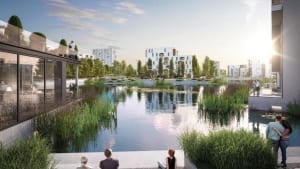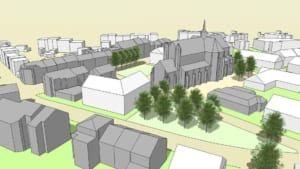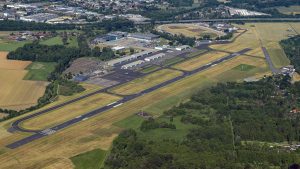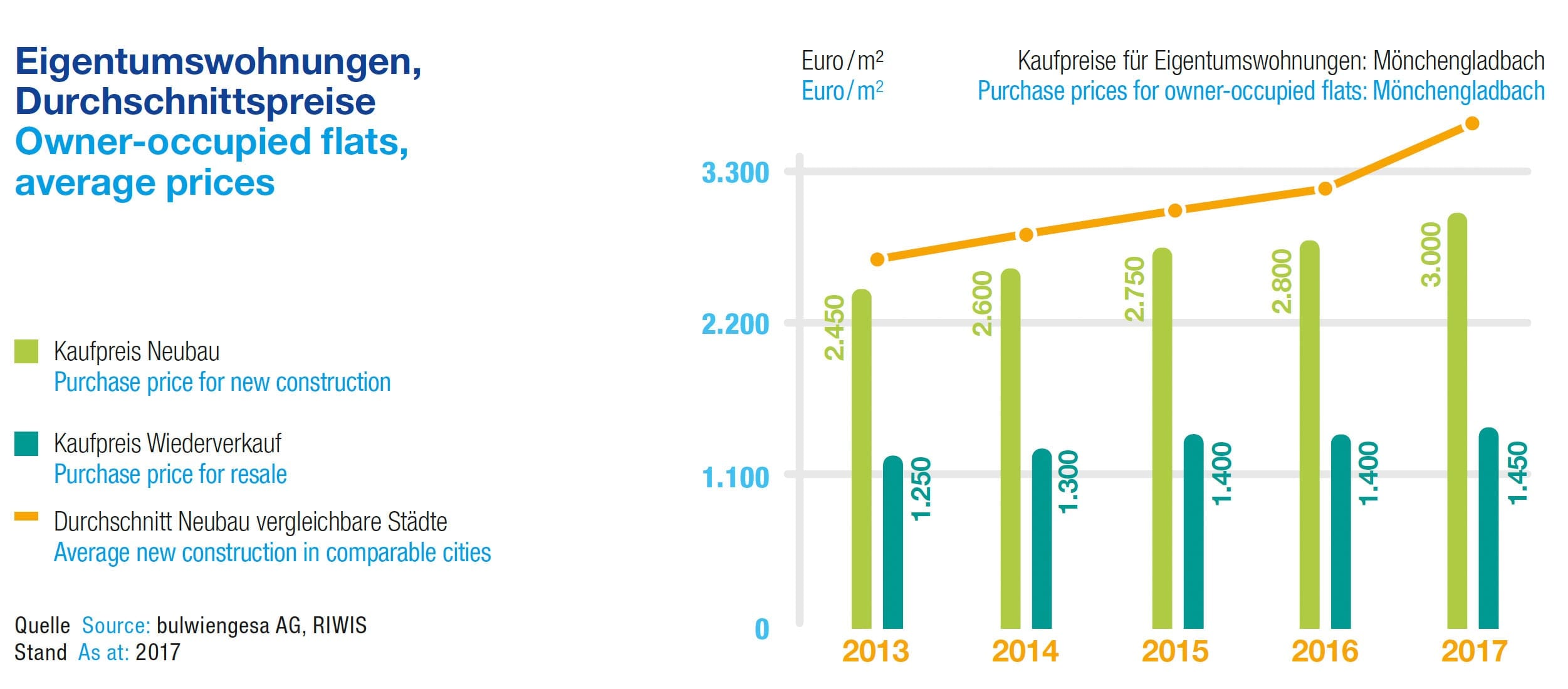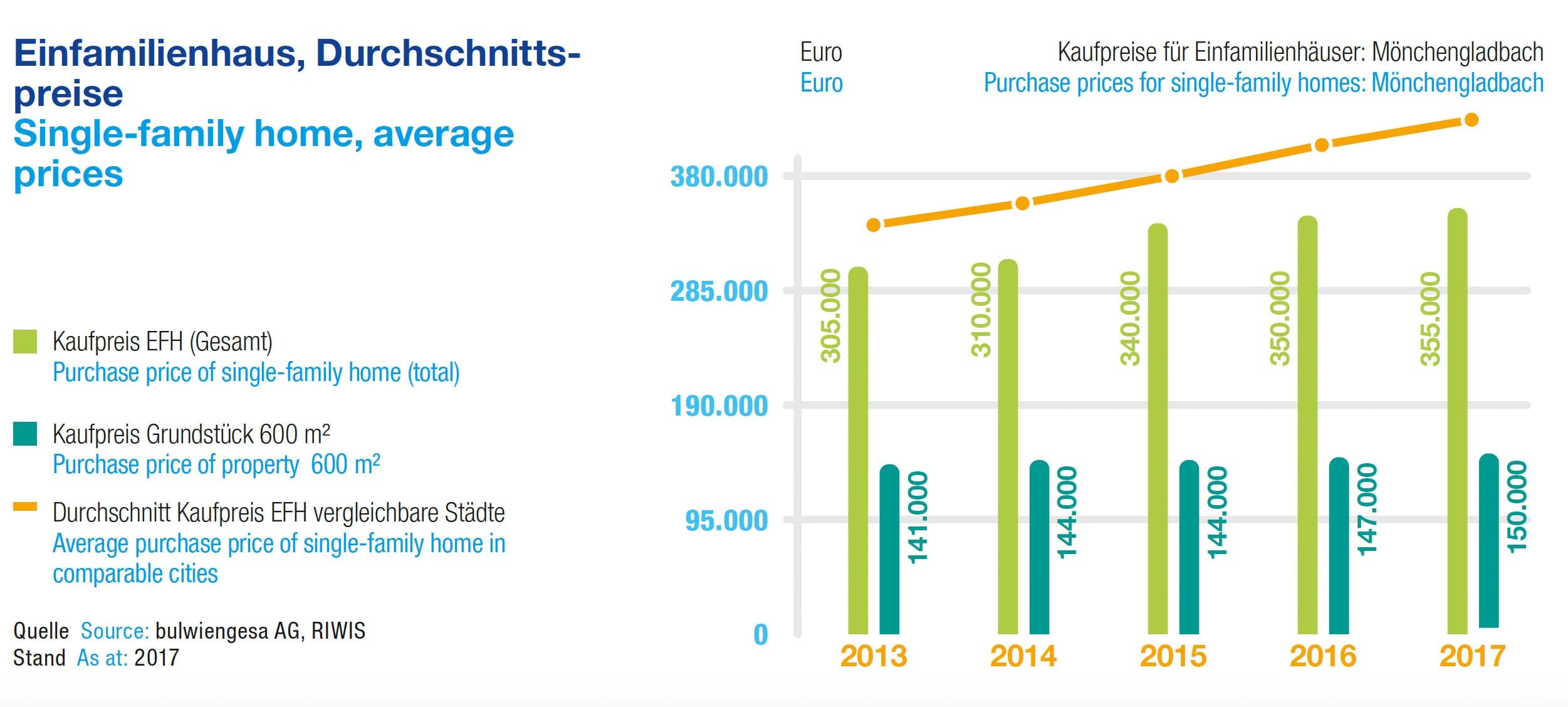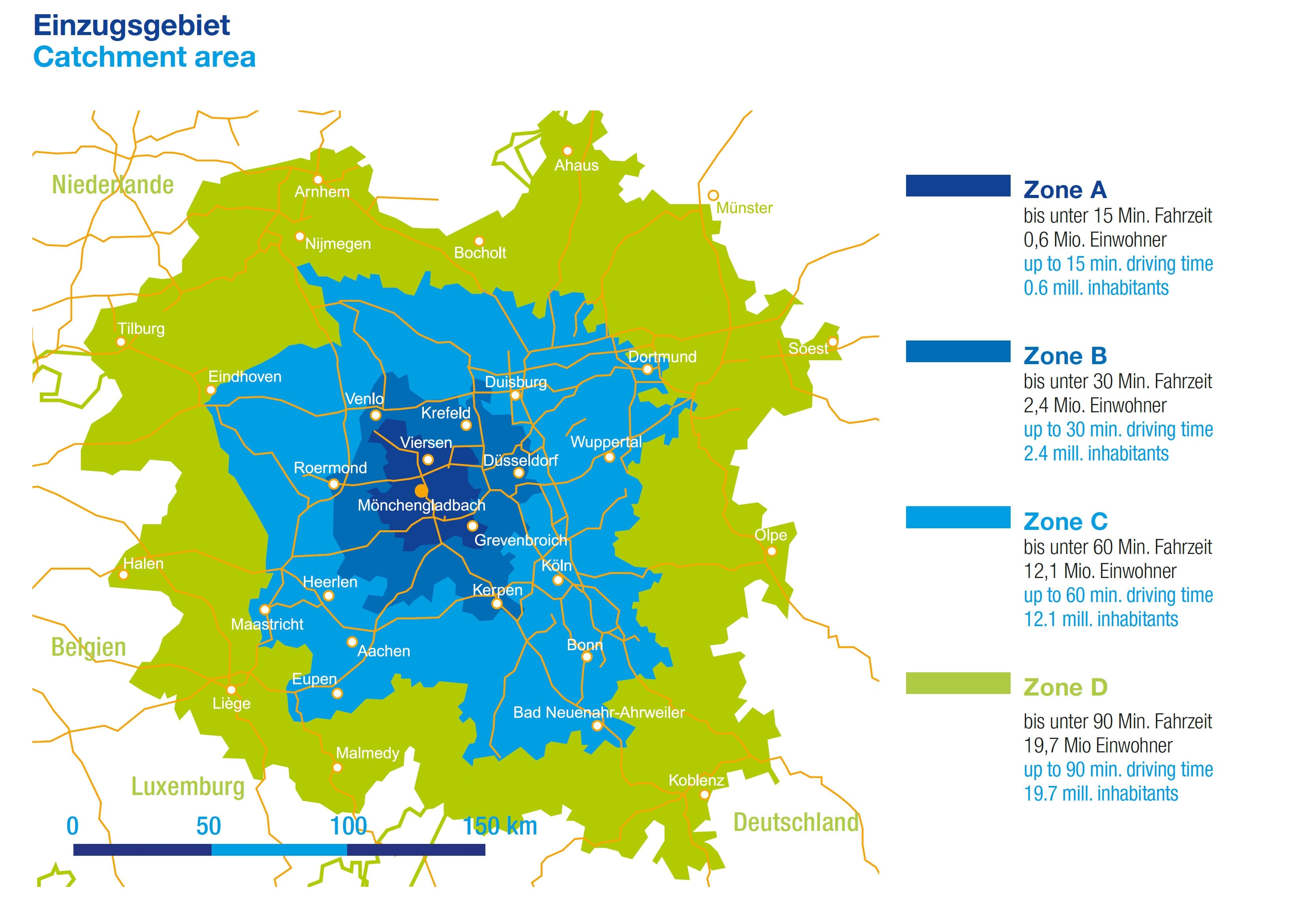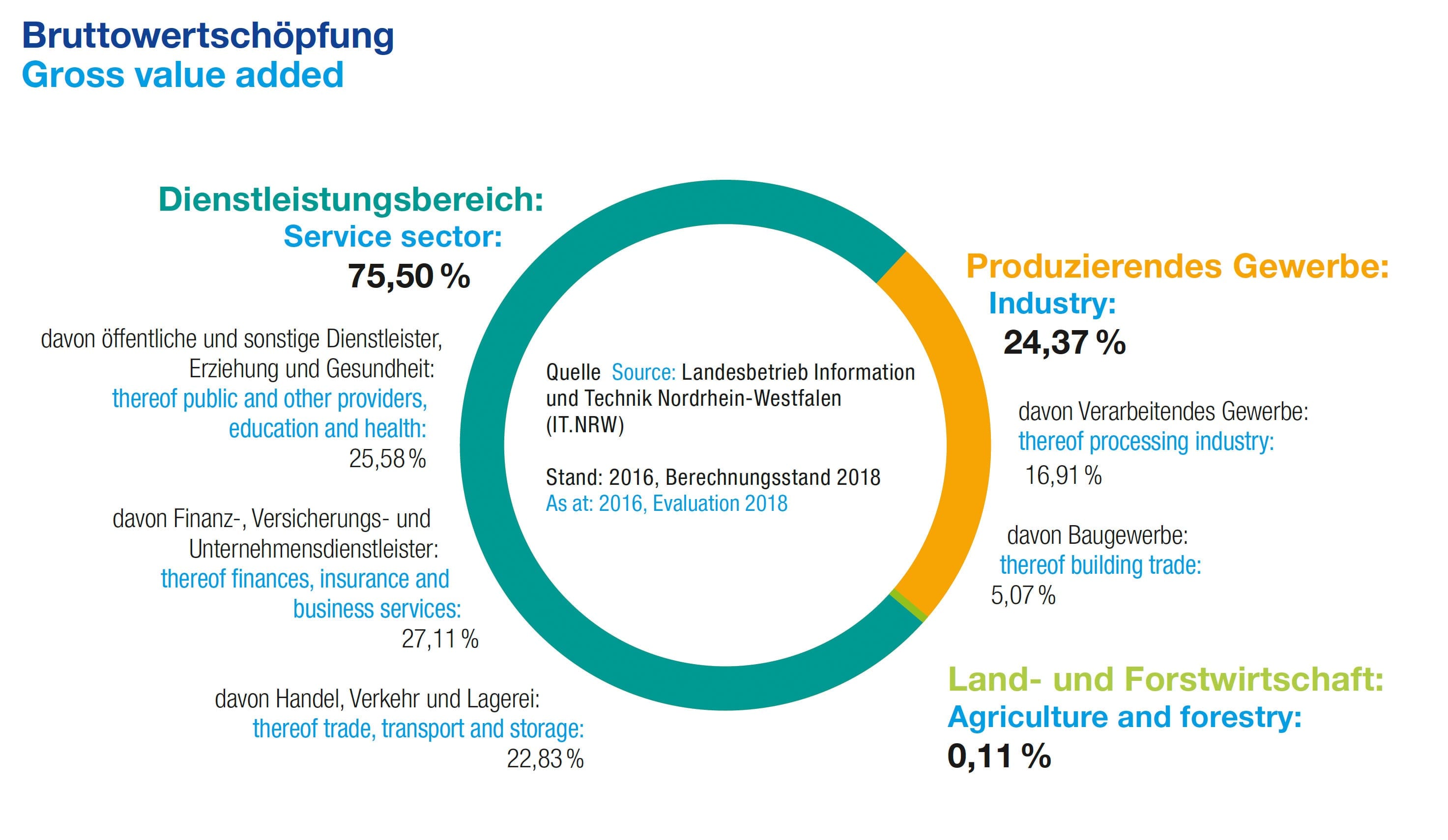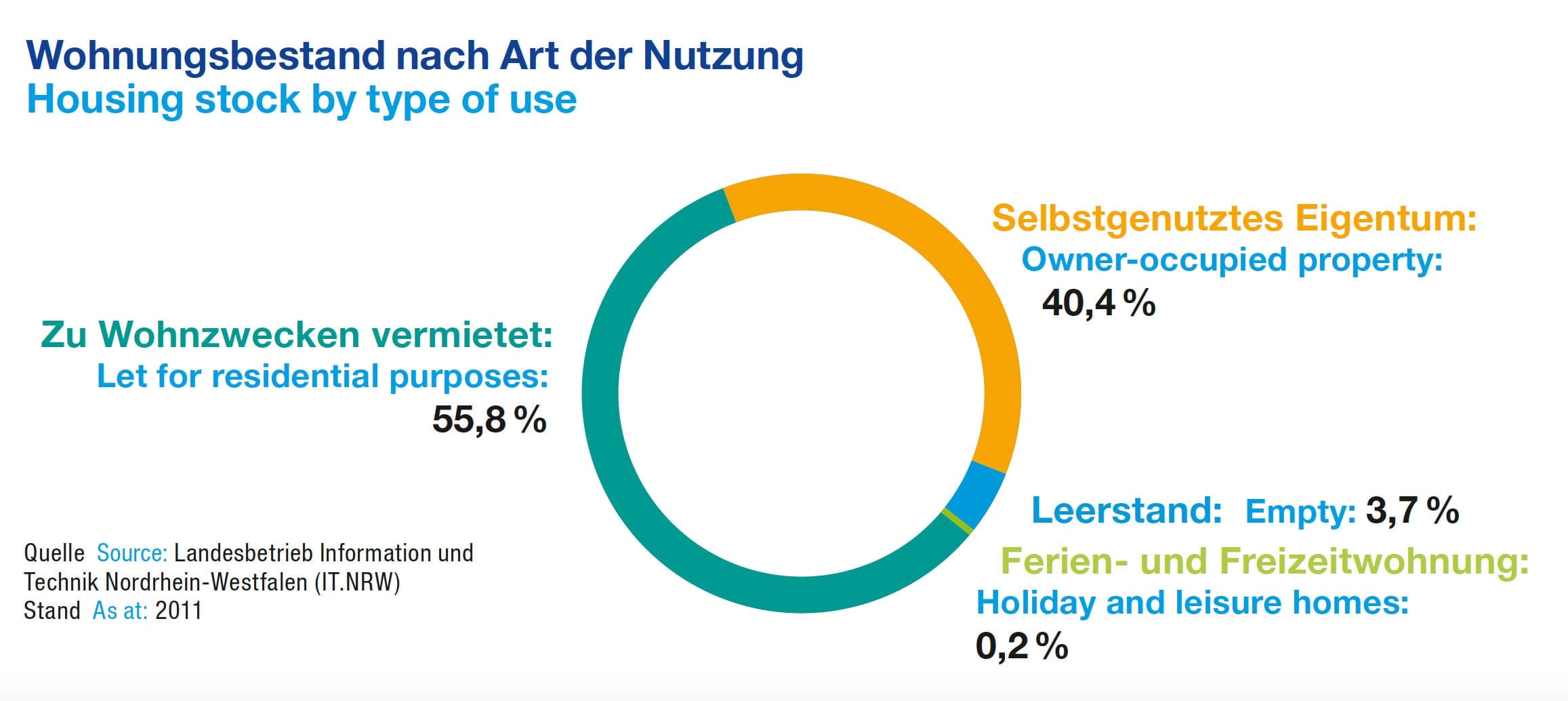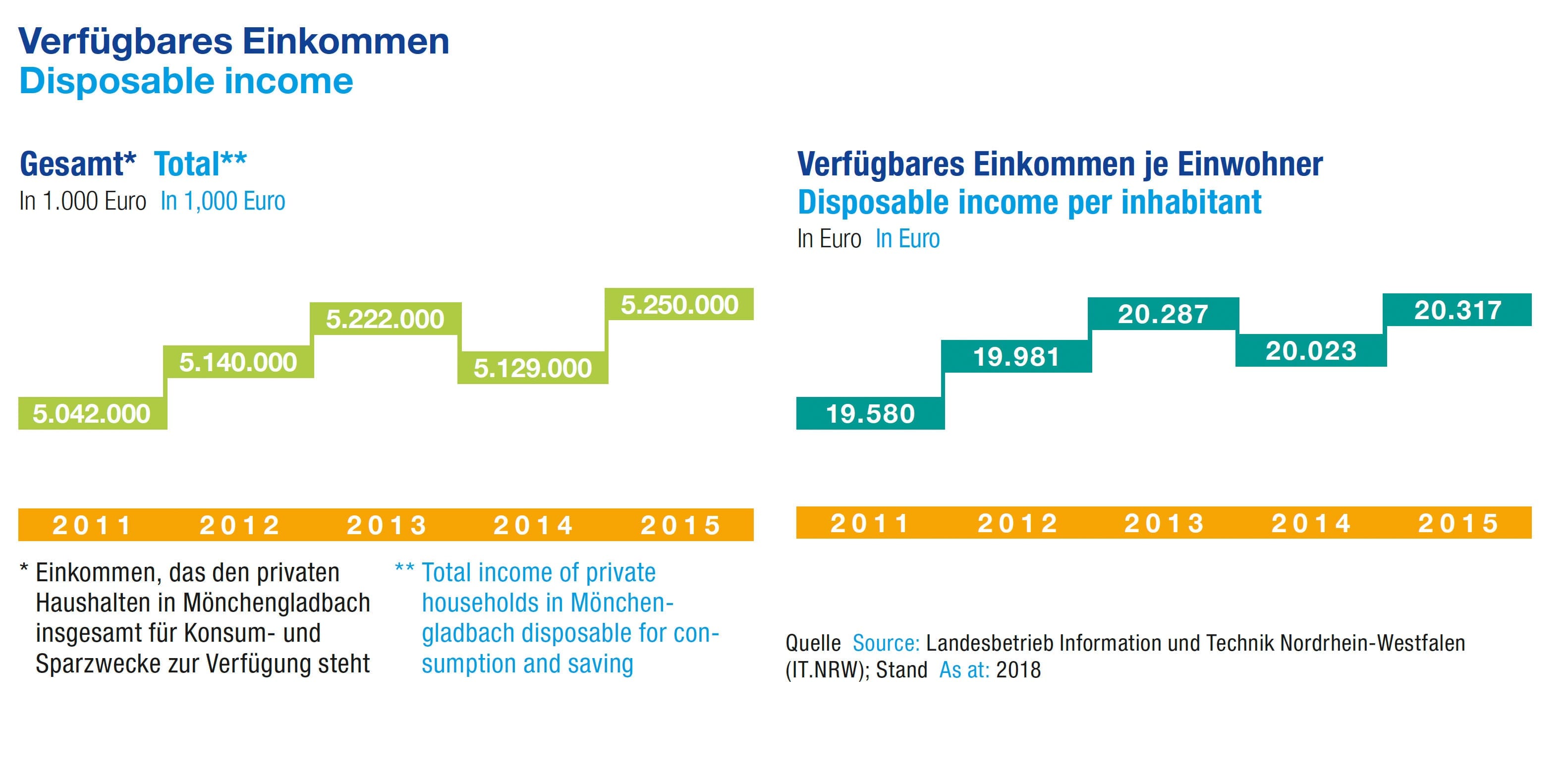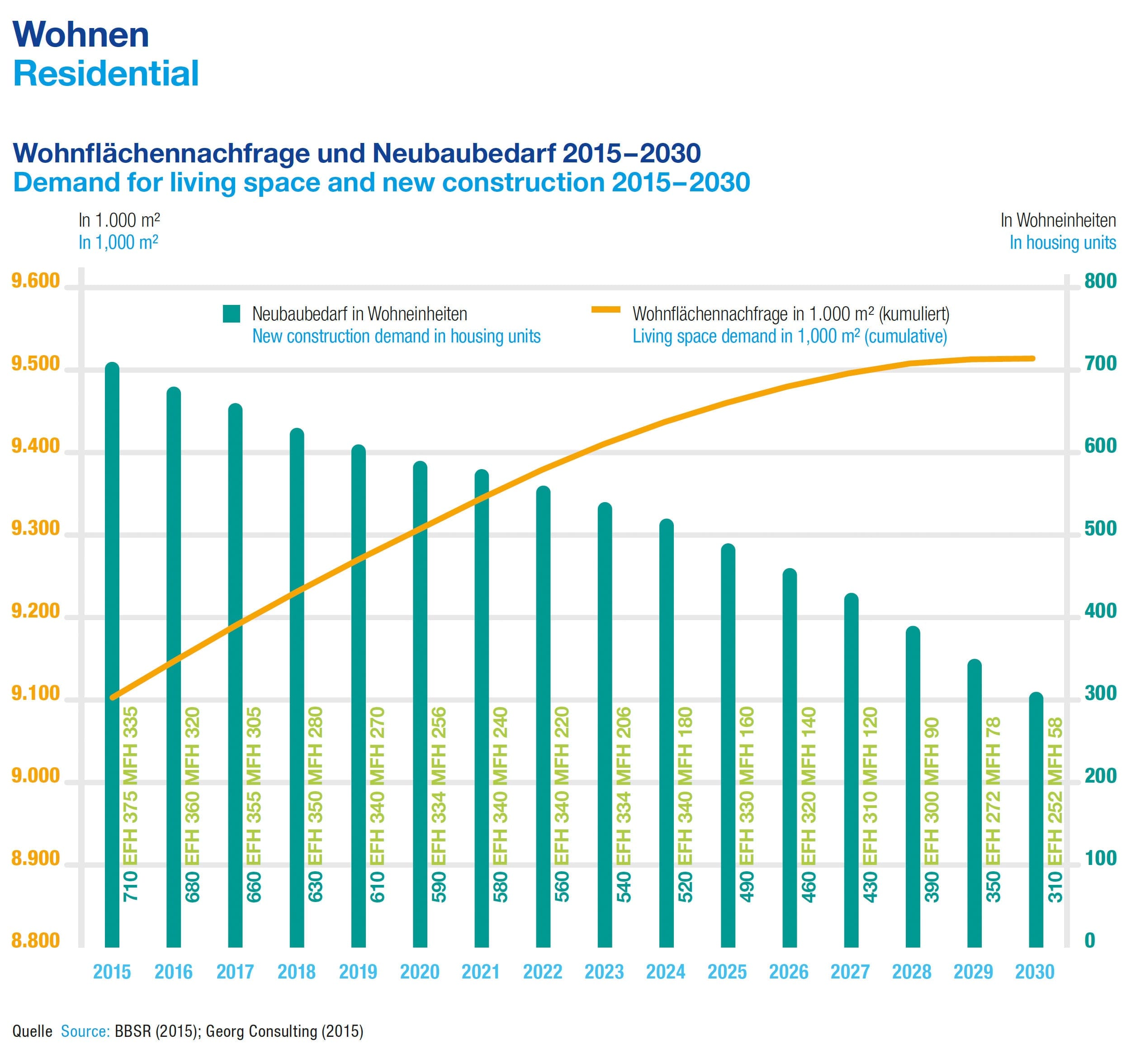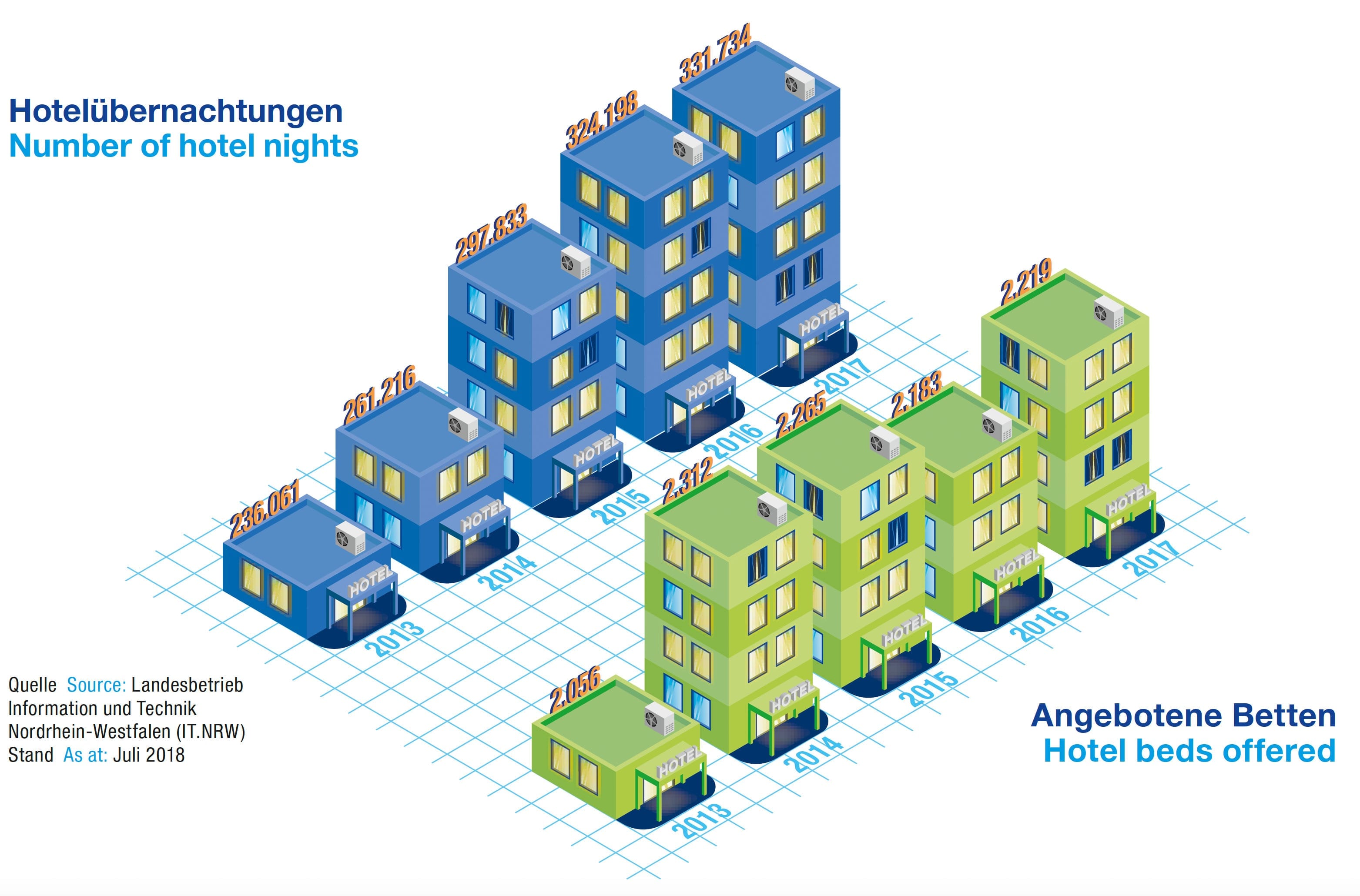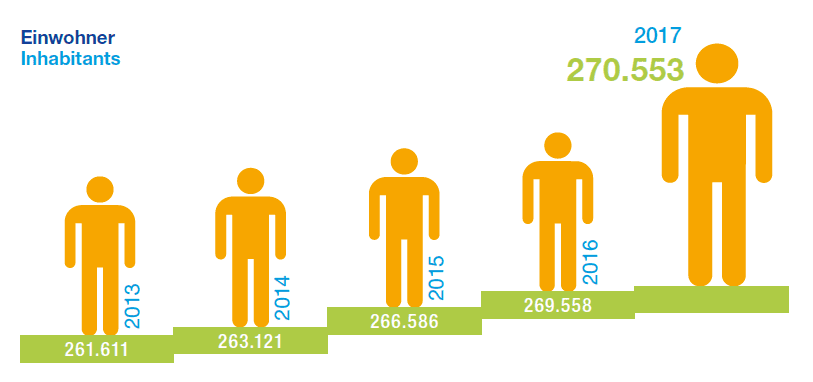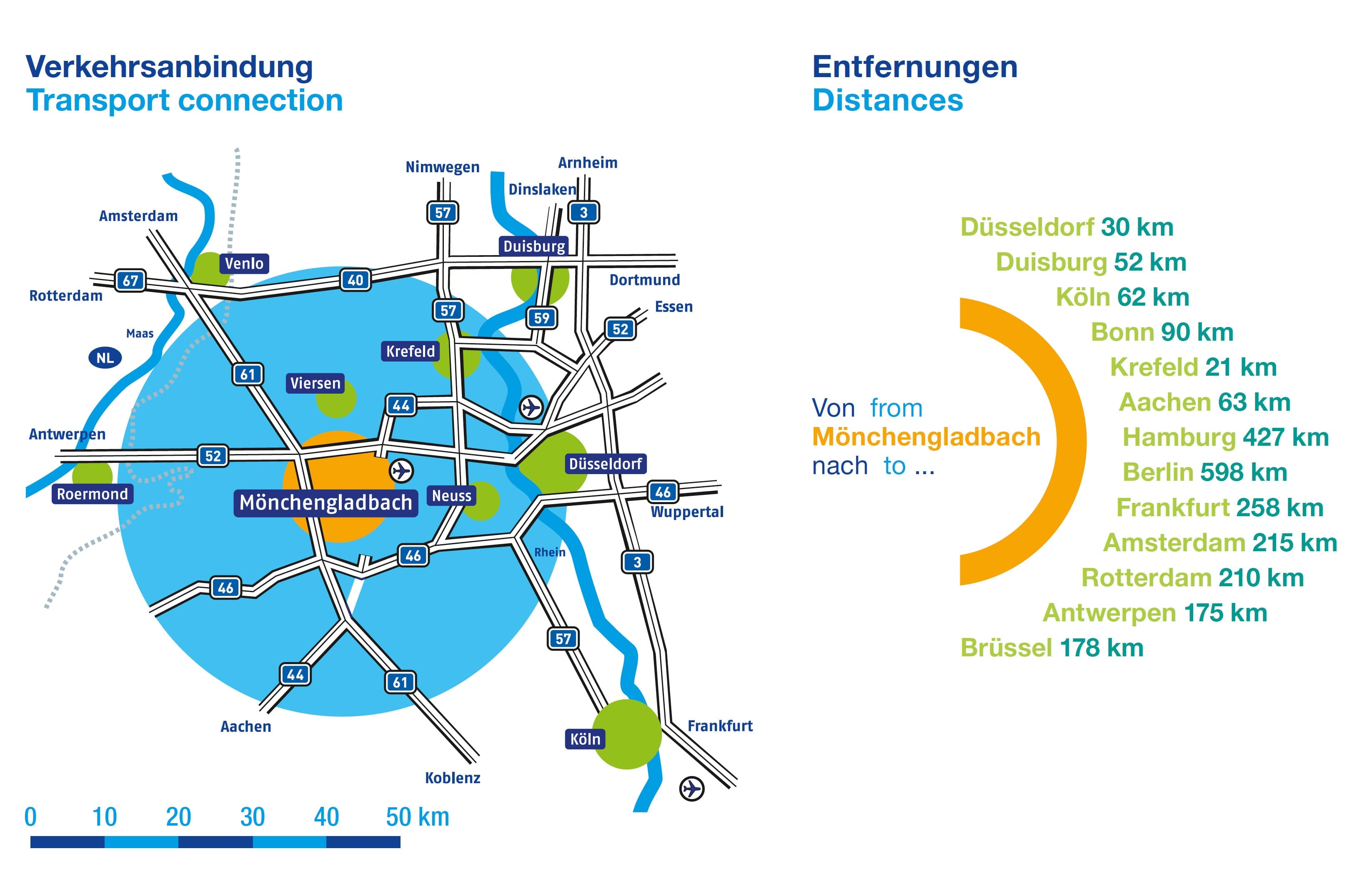A
Abteiberg framework plan
One of the central stimulus projects for Mönchengladbach is the Abteiberg and the surrounding neighbourhood. A dedicated framework plan addresses three core action areas for the prestigious site: the old city, Gladbachtal and the Kulturgarten with Hans-Jonas-Park and Haus Erholung.
Average prices owner-occupied flats and single-family homes
B
Business development
WFMG – Wirtschaftsförderung Mönchengladbach GmbH is the link between business, administration and politics in the city. The top priority is creating jobs by encouraging companies to locate in Mönchengladbach. To that end, WFMG sells land belonging to the city and provides assistance with commercial properties. In addition, WFMG provides local support for companies which have settled in the city and offers them a wide range of networks for sector-specific and cross-sector interchange.
C
City WiFi
Since September 2018, visitors to Mönchengladbach and Rheydt city centres have been able to surf the Internet using the free municipal WiFi network. High street retailers and restaurants can also use the city WiFi to present digital promotions.
Catchment area
Cost of living
Mönchengladbach is a genuine alternative to the metropolitan areas in North Rhine-Westphalia (NRW). One point in favour of the Lower Rhine city is the cost of living, which is about 20 percent lower than in NRW’S capital city. Rents and purchase prices for flats and offices are on average one third lower than in Düsseldorf.
D
Demography
The demographic change is leaving its mark on Mönchengladbach, too. The Wegweiser Kommune (Community Roadmap) national data portal forecasts a declining birth rate in the city up to 2030 coupled with a rise in the population aged 65 and older. The share of the over-80s will continue to grow.
E
Employment figures
At the end of 2017, 98,004 employees liable to social security contributions were registered with the Agentur für Arbeit (Federal Employment Agency). A large proportion (20.3 %) is employed in the service sector, in retail (15.7 %) and in the manufacturing sector (16.4 %). 5.1 % works in the construction sector. In addition, the city has made a name for itself as a hotspot for e-commerce.
Education
Education is one of Mönchengladbach’s strong points. Among other things, the city is one of Europe’s major study centres for the next generation of textile engineers. The new Textile Academy at Hochschule Niederrhein University of Applied Sciences, opened in 2018. Innovative and high-performance, both inside and out, with a façade made of textiles. Targeted projects initiated by a foundation called MGconnect Stiftung encourage young people still at school to start a career in Mönchengladbach and help them make the transition from school to working life.
Economic strength
Mönchengladbach is a strong business location with efficient enterprises. Gross domestic product in 2016 ran at €8.7 billion – a 5.1 percent year-on-year increase. Gross domestic product per person in employment averaged €65,320 – a productivity increase of 4.4 percent compared with 2015.
(Source: Arbeitskreis “Volkswirtschaftliche Gesamtrechnungen der Länder” (Working Group “Regional Accounts”))
G
Gross value added
Green spaces and environment
With almost 50 percent of urban green areas, Mönchengladbach offers plenty of space for recreation and a high quality of life. The urban development strategy mg+ Wachsende Stadt addresses environmental issues with projects devoted to free space, climate and mobility. An important building block for the construction sector is the Healthy Building Network.
H
Household sizes
Healthy Building Network
The Healthy Building Network (HBN) INTERREG project is designed to transform the region into a competence centre for sustainable, healthy building. HBN is a knowledge platform and an innovation network for creating an awareness of healthy building and inspiring companies to use sustainable and energy efficient materials. The project runs until 2021.
Each “Healthy Building” helps the city to grow quality-wise and encourages innovative businesses to locate on a permanent basis.
Housing rents
Housing stock by type of use
K
Kapuzinerplatz: Market hall
A new culinary experience is taking shape on Kapuzinerplatz in Gladbach city centre. Exclusive fresh produce and delicacies will soon be available in the approx. 1,000 m2 hall.
L
Logistics
Mönchengladbach has developed into a hotspot for logistics and e-commerce. 5,000 new jobs have been created in Regiopark over the last years. Names like DHL, Adidas, Primark, L‘Oreal Luxe, Coca-Cola, Esprit, Zalando and Amazon speak for themselves.
M
Mönchengladbach Airport
EWMG acquired the majority stake in Mönchengladbach Airport in 2018. A total of 647 people were employed by the airport company itself and the firms operating from the location in 2018, with a rising trend. After Frankfurt-Egelsbach, Mönchengladbach is the second largest general aviation airport in Germany.
mg+ Wachsende Stadt
mg+ Wachsende Stadt is the urban development strategy signed off by the city of Mönchengladbach in 2016. Four action areas were defined for the project-driven implementation of the strategy: revitalising the residential and social environment, improving environmental conditions, strengthening the business location and reinforcing soft location factors.
Maria Hilf terraces
A new residential quarter is being created on the site of the former Maria Hilf Hospital; this new development promises one thing in particular – a place to live for everyone. Right in the heart of the city, a 4.4 hectare site is being developed into a green urban space that is a good place to live – pedestrianised and barrier-free, with ideal links to Gladbach’s business centre.
N
New construction to 2030
Nordpark
Nordpark has established itself as an international business park. Big names such as Santander Consumer Bank and van Laack along with numerous SMEs have located here. And the numbers keep on growing. In addition, Nordpark is the top address for soccer fans. Borussia’s new four-star hotel operated by the H-Hotels Group is a prestige project that combines the world of business and the world of sport. Located right next to the stadium, it is the ideal venue for soccer fans and other visitors to the stadium as well as business travellers meeting with companies located in Nordpark.
P
Population development
Parken MG
Parken MG GmbH, a wholly-owned subsidiary of EWMG, began operating on January 1, 2018. Its mission: to manage all public-access municipal underground and multi-storey car parks in the city. For economic and urban planning reasons, all municipal underground and multi-storey car parks are to be managed by the city itself with a view to steering developments more effectively.
Q
Quality of life
Life is good in Mönchengladbach: a high proportion of green spaces, a lower crime rate and fewer traffic jams than in Düsseldorf, 180 children’s playgrounds and dynamic urban development are just some of the arguments in favour of the Lower Rhine city.
R
Real estate and trade tax
REME site
The 15-hectare REME site, formerly used by the British Army of the Rhine, is located in the east of Mönchengladbach. The site is a significant part of the city district of Lürrip, and about 400 residential units are to be built there. In addition there are plans for restaurants and small commercial units. A key element in the development will also be the rehabilitation of the Gladbach stream in the south of the plan area.
S
Start-up dynamics
Mönchengladbach has a vibrant and innovative start-up scene. WFMG supports potential start-up founders on their road to professional independence. The start-up week called “START-UP MG!” is one of the year’s major highlights.
Stimulus projects
Mönchengladbach has initiated inner-city stimulus projects such as Seestadt mg+ or Maria Hilf terraces under its urban development strategy mg+ Wachsende Stadt. The aim is qualitative development in the city centre.
Seestadt mg+
The Swedish company Catella is transforming the 14-hectare area near Mönchengladbach main railway station into an entirely new district named Seestadt mg+.
A lake (“See”) is to form the heart and the unique selling proposition of the quarter and give this urban location a special flair for living, working, relaxing, sport, culture and encounters. Up to 2,000 residential units to meet all requirements are to be created at Seestadt mg+, together with space for various types of business, restaurants, leisure facilities and social infrastructure.
Smart city
Mönchengladbach has set out to become a smart city, and has laid important foundations for innovative technological applications with the city WiFi. At the Smart City Forum Niederrhein in 2018, WFMG teamed up with nextMG to present ideas, products and systems for a smart city: intelligent dustbins, networked charging stations for electric vehicles, optimized real-time parking guidance systems, drones that take defibrillators to patients having a heart attack as quickly as possible, and lots more.
U
Unemployment rate
The unemployment rate has fallen to 8.8 percent in recent years (as at December 31, 2018, source: Agentur für Arbeit (Federal Employment Agency)).
University
Hochschule Niederrhein is based in Mönchengladbach and Krefeld. The university has some 15,000 students, making it the fourth largest university of applied sciences in Germany and the second largest in North Rhine-Westphalia after TH Köln. Apart from technology and economics degree programmes, Hochschule Niederrhein is above all well known for textile and clothing technology.
Z
Zalando & Co.
Mönchengladbach has made a name for itself as an international hotspot for logistics and e-commerce. Apart from global players such as Coca-Cola or Zalando, Amazon has also decided in favour of Mönchengladbach, and is creating 1,000 permanent jobs at a state-of-the-art logistics centre with the option to expand further.



